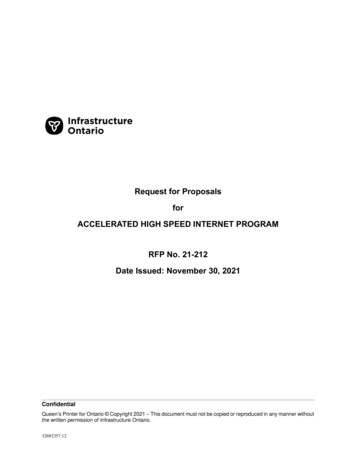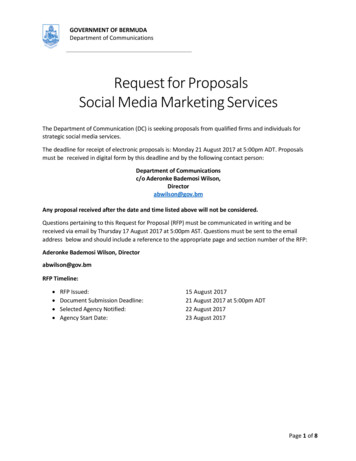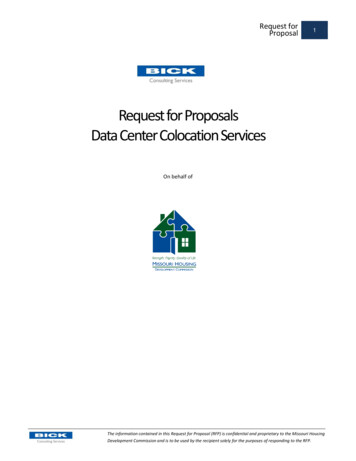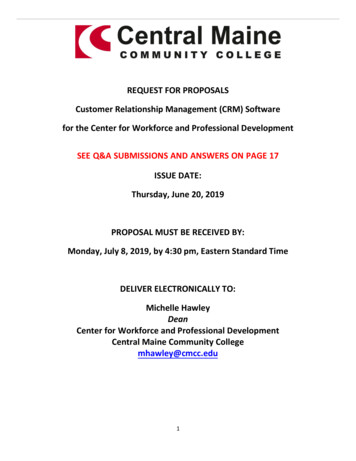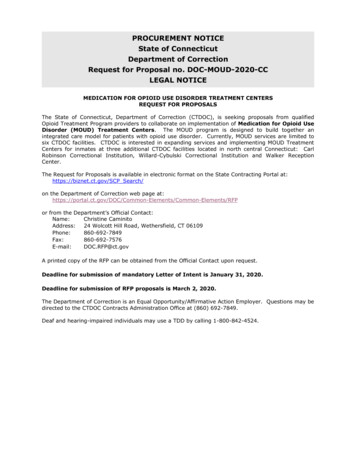
Transcription
Request for Proposals for Design and Engineering SupportServices for the Last Mile Networks ProjectRFP No. MBI-2016-02NOTE: Enclosed are excerpts of the full RFPMassachusetts Technology Collaborative[Massachusetts Broadband Institute]75 North DriveWestborough, MA 01581-3340http://www.masstech.org[DRAFT RELEASED FOR MUNICIPAL REVIEW ANDCOMMENT ON DECEMBER 24, 2015]
Request for ProposalsFor Design and Engineering Support Services for the Last Mile Networks ProjectRFP No. MBI-2016-021 IntroductionMassachusetts Technology Collaborative (“Mass Tech Collaborative”), on behalf of MassachusettsBroadband Institute, is issuing this Request for Proposals for Design and Engineering Support Services forthe Last Mile Network (RFP No. MBI-2016-02) (the “RFP”) to solicit responses from qualified contractors(“Respondents”) with experience in design and engineering Last Mile networks (e.g. Fiber-to-the-Premise(FTTP), wireless networks). Respondents will be competing in an open procurement to provide the design,project management, project support, and consulting services set forth herein (the “Services”). Thesubmissions of all Respondents shall be compared and evaluated pursuant to the evaluation criteria setforth in this RFP, and a single Respondent shall be selected.Mass Tech Collaborative will be the contracting entity on behalf of Massachusetts Broadband Institute. Forthe purposes of this RFP (and except where the specific context warrants otherwise), MassachusettsBroadband Institute, MBI and Mass Tech Collaborative are collectively referred to as Mass TechCollaborative.1.1 Key Principles All procurements will be conducted in accordance with applicable Massachusetts laws governingthe design and construction of public works projects.Mass Tech Collaborative will utilize a design-bid-build approach for ALL elements of the project.Mass Tech Collaborative may approach the construction work by dividing it up into smallergroupings or clusters of towns that decide to participate in a centralized design and constructionprocess administered by Mass Tech Collaborative. The size and composition of the clusters couldbe based on the timing of town decisions to make binding commitments to authorize a broadbandproject and other factors that create logical and manageable groupings.Mass Tech Collaborative will release a construction bid package for each cluster of towns. Eachconstruction bid package will incorporate a final design with precise specifications for all elementsof the work, including procurement and installation of equipment, materials and supplies (insideplant and outside plant).The design of the last mile network(s) will incorporate the relevant portions of the MBI Last MileProgram Policy Statement (See Attachment I) that was approved by the MBI Board of Directorsand the Executive Committee of the Mass Tech Collaborative Board of Directors. For example,the design must accommodate the near-term preferences of each participating town and providesufficient downstream flexibility to allow a participating town to join or leave a regional network.1.2 Characterization (Essential Features) of the Project Mass Tech Collaborative has been charged by the Commonwealth of Massachusetts with buildingout broadband infrastructure in the 44 remaining towns in western Massachusetts that do not meetthe Federal Communications Commission (FCC) minimum broadband speed of 25 Mbps downand 3 Mbps up.Mass Tech Collaborative has already built a robust fiber, carrier class, middle mile network thatruns through towns in western and north central Massachusetts. Mass Tech Collaborative isseeking to leverage the middle mile network to extend infrastructure in these 44 unserved towns.Considerations associated with an additional distribution layer between towns will need to beaddressed.While many of the towns have expressed an interest in a regional, FTTP network, other townshave yet to decide on the best option to meet their needs. Open issues for many of these townsinclude:o Opt in or opt out to contracting with Mass Tech Collaborative to design and construct FTTPnetwork. Some of the 44 towns may elect not to proceed with a broadband project.o Choice of technology – GPON vs. active Ethernet; fiber vs. wireless vs. hybrid fiberwireless.o Operation and/or provisioning of services on the municipal network – who will operate thenetwork for the town? Will the town be part of a larger regional network? Who will beMunicipal Review Draft (December 24, 2015)2
Request for ProposalsFor Design and Engineering Support Services for the Last Mile Networks Project RFP No. MBI-2016-02selected to provide services? What are the technical requirements needed to support theservices the provider wishes to offer?o Extent of the coverage within each town – balancing ubiquitous access vs. cost of reachingoutliers.o Where fiber drops will be terminated during construction – Fiber to the Curb (FTTC) vs.Fiber to the premise (FTTP).Mass Tech Collaborative will work with each interested town to help the town make an informeddecision on whether to proceed with a broadband project and the nature of the broadband projectto be implemented. The Design-Engineering (“D/E”) firm will support Mass Tech Collaborative withtown education and outreach efforts.Each participating town is required to co-invest and cover approximately 2/3 of the capital cost tobuild a ubiquitous FTTP municipal network in that town. Several towns have taken initial steps tomove forward to authorize the issuance of Government Obligation (“GO”) bonds to cover thetown’s share of the capital costs. The actual number of towns that will ultimately decide to financebroadband infrastructure under the current program, and the timing of such decisions, is uncertain.Broadband infrastructure that is built in a participating town will be owned by that town.1.3 Structure of the D/E ProcurementIt is Mass Tech Collaborative’s intent and strong preference to conduct a single procurement for a D/E firmthat will support this multi-year project through its conclusion. The services of the selected D/E will proceed on a phased basis.This RFP provides a detailed scope for an initial program development phase (Phase 1).This RFP provides an illustrative, preliminary scope of services for Phase 2 project execution workthat represents Mass Tech Collaborative’s current thinking on the broader range of services thatthe selected D/E firm will provide over the life of the project.D/E bidders will submit a fixed price proposal for the program development phase (Phase 1).D/E bidders will submit hourly rates and estimated level of effort for personnel that would performPhase 2 services (based on the preliminary list of Phase 2 services as described in section 3.2.2of this RFP). Bidders will also provide staff and firm qualifications for the Phase 2 work.If the selected D/E firm performs satisfactorily on the initial program development phase, MassTech Collaborative intends to work with the D/E firm to reach mutual agreement on a final scopeand budget for the subsequent Phase 2 work. The final scope will be informed by the outcomesof the program development phase.2 Background on Sponsors and Project2.1 The Last Mile NetworkOf the towns and cities included in the MassBroadband 123 network, 79 are served to varying degrees byan incumbent or new cable broadband provider but the remaining 44 towns in the MassBroadband 123footprint are low density, rural areas that do not have an incumbent cable broadband provider and arereferred to as “unserved.” The Mass Tech Collaborative is addressing the last mile challenge with the goalof making high-speed Internet available to unserved residents and businesses within the 44 unservedtowns.The Commonwealth has responded to the last mile challenge with a 50 Million appropriation of statecapital funding (Chapter 257 of the Acts of 2014) enacted in August of 2014 to support the build-out of lastmile infrastructure in western Massachusetts. Of these funds, 40 million have been allocated for theunserved towns. Mass Tech Collaborative’s main objective is to develop solutions to offer broadbandaccess for households and businesses that maximize the impact of limited public resources, leverage othersources of funding (to the extent necessary and appropriate), and promote economic growth in the region.Most of the Last Mile Network will constitute the installation of new fiber optic cables attached to existingutility poles. Mass Tech Collaborative plans to construct about 2,040 miles of new fiber optic cabling inwestern Massachusetts with approximately 29,000 homes being passed based upon current desk top townMunicipal Review Draft (December 24, 2015)3
Request for ProposalsFor Design and Engineering Support Services for the Last Mile Networks ProjectRFP No. MBI-2016-02model estimates. Mass Tech Collaborative anticipates that the Last Mile network may consist of multipleFiber-to-the-Premises (“FTTP”) Gigabit-capable Passive Optical Network (GPON), Active Ethernet (AE)networks or a combination thereof. Mass Tech Collaborative also anticipates a wireless component mayneed to supplement areas where homes are unreachable and fiber cabling is not deemed practicable orcost effective.2.2 Project Stakeholders2.2.1 Massachusetts Technology CollaborativeMass Tech Collaborative is an independent public instrumentality of the Commonwealth of Massachusettschartered by the Commonwealth to serve as a catalyst for growing its innovation economy. Mass TechCollaborative brings together leaders from industry, academia, and government to advance technologyfocused solutions that lead to economic growth, job creation, and public benefits in Massachusetts. MassTech Collaborative energizes emerging markets in the high-tech sector by filling gaps in the marketplace,connecting key stakeholders, expanding broadband services, conducting critical economic analysis, andproviding access to intellectual and financial capital. Mass Tech Collaborative has three primary divisions:The Innovation Institute at Mass Tech Collaborative, the Massachusetts Broadband Institute, and theMassachusetts e-Health Institute. For additional information about Mass Tech Collaborative and itsprograms and initiatives, please visit our website at www.masstech.org.2.2.2 Massachusetts Broadband Institute (MBI)The MBI is the central broadband program for the Commonwealth. The MBI was created on August 4,2008, when Governor Deval Patrick signed Chapter 231 of the Acts of 2008, An Act Establishing andFunding the Massachusetts Broadband Institute (the “Broadband Act”). The primary mission of the MBI isto extend affordable, robust, high-speed Internet access to all homes, businesses, schools, libraries,medical facilities, government offices and other public places across Massachusetts, with a focus on thehard-to-serve areas of western and central Massachusetts. For more information about the MBI and itsprograms and activities generally, please visit the web site at www.massbroadband.org.2.2.3 Towns and/or Municipal Lighting Plants (MLPs)The Last Mile project is intended to bring broadband services to unserved towns in western Massachusetts.Interested towns willing to take part in the Last Mile project will be required to obtain funding to pay for twothirds of the total cost of their towns build-out. Towns will own the infrastructure and assets that are built inparticipating town upon completion of the project.A town may create a Municipal Lighting Plant (MLP) which are public corporations formed for the purposeof furnishing efficient, low cost, and reliable electric power, energy-related services and cable televisionservices. Any number of municipal lighting plants may associate themselves together and with other publicorganizations.2.3 Roles and Responsibilities2.3.1 Mass Tech CollaborativeMass Tech Collaborative’s primary role and responsibility is to serve as the project “sponsor” and toperform overall management of the Last Mile project. Mass Tech Collaborative will contribute information,provide recommendations, articulate strategic plans, review deliverables, and approve design changes.Mass Tech Collaborative will engage design and engineering and construction firms as well as otherproject consultants deemed necessary. Mass Tech Collaborative will report to the towns, its Board ofDirectors and other stakeholders.2.3.2 Towns and/or Municipal Lighting Plants (MLPs)Towns and their MLPs are the customers of Mass Tech Collaborative. Each town will ultimately own thelast mile network built in the town. A town may have its MLP serve as the political body responsible in thedecision making process for each town and will provide high-level requirements for its Last Mile network.Mass Tech Collaborative will communicate directly with the towns or their MLPs.Municipal Review Draft (December 24, 2015)4
Request for ProposalsFor Design and Engineering Support Services for the Last Mile Networks Project2.3.3RFP No. MBI-2016-02Project Team2.3.3.1 Design Engineering FirmDesign Engineer services will be performed by the awarded respondent to this RFP. The D/E firm selectedwill not be eligible to construct any of the Last Mile Networks. Select personnel from the firm will be requiredto work in the Westborough, MA office to work closely on a day to day basis with Mass Tech Collaborativepersonnel. The selected D/E firm’s primary role and responsibility will be to perform design, engineeringand project management services for up to 44 towns in the Last Mile networks project as specified in section3.2. The selected D/E firm is currently expected to have the following high level responsibilities: Design Last Mile networks,Create system specifications and test procedures,Inspect all system functions related to the Last Mile networks,Perform project management tasks as specified,Oversee the pole and conduit licensing process and conduct pole data collection,Recommend vendor equipment,Prepare bid packages for each construction cluster,Perform construction QA/QC,Ensure system specifications are being met by construction management firm(s) and/or itssubcontractors in the Access, Distribution, Core, and Service layers,Coordinate testing, andHire or manage sub-contractors or other project vendors.Mass Tech Collaborative will provide Westborough, MA office space for the D/E firm that accommodatestwo persons. This “float space” will be used to support integration between the D/E firm and the Mass TechCollaborative team. Each workspace (cubicle) will include a telephone, internet access and power.Personnel will be granted standard work day building and office access capabilities.2.3.3.2 Construction Management FirmConstruction Management (CM) firm(s) will perform multiple construction disciplines for different aspects ofthe project such as outside plant (OSP), inside plant (ISP), active electronics, and civil construction ofnetwork shelters. A CM firm will be hired for each construction cluster and will be responsible to performthe work specified in the construction bid package which may include subcontracting to construction orprofessional service companies if necessary.Mass Tech Collaborative intends not to impose the risk for make ready work on the CM and will work withthe D/E firm to develop a project approach for scheduling and sequencing of construction to accomplishthis objective. The CM, however, will still assume full responsibility for implementing the final design.2.3.3.3 Route Facility OwnersRoute Facility Owners are the owners of poles, conduit, railroad structures and bridges to which fiber of theProject may be attached or through which fiber of the Project may pass. The pole, conduit, etc., are referredto in this RFP as Route Facilities. Many Route Facility Owners process applications for licenses to makesuch attachments or otherwise to use such Route Facilities. Part of that application process involves makeready work. Route Facility Owners also have insurance requirements.2.3.3.4 Property OwnersProperty Owners are the owners of homes, business and other premises to which fiber of the Project maybe attached to structures or through which fiber of the Project may pass aerially or below ground. Thehomes, business, etc. are referred to in this RFP as Premises. Access to Property Owners’ privateproperties can only be obtained with prior written consent of the Property Owner.3 Services RequiredMunicipal Review Draft (December 24, 2015)5
Request for ProposalsFor Design and Engineering Support Services for the Last Mile Networks ProjectRFP No. MBI-2016-023.1Design Engineering Qualifications and Project Management ServicesMass Tech Collaborative is requesting responses to this RFP) for services to design and engineer variousoptions in building a multi town/single town wide FTTP network(s). These network(s) will providebroadband services to residents and businesses in up to 44 towns in western Massachusetts.Mass Tech Collaborative expects the selected firm to provide final design options for a complete FTTPsolution utilizing GPON and/or AE. The FTTP networks will be building off the MassBroadband 123 fiberoptic network present within each town in the design areas. The D/E firm is expected to propose plans thatwould offer Video, VoIP and Data. It is expected that the preliminary design for the first construction clusterwill be completed within 4 months from the start of the execution phase.The D/E firm will create an overall project plan with the input from Mass Tech Collaborative. The D/E firmwill manage to this plan with scheduling input from all CMs and subcontractors throughout the life cycle ofthe project.To participate in this RFP, respondents or their subcontractors must possess the following minimumqualifications and provide supporting documentation. 3.2Designed and managed a minimum of three FTTP projectsExperienced with large public (state and/or federal) fiber optic/broadband projectsProven ability to project manage, design and document fiber optic cable installations and havedesigned and/or managed a project with similar scope and scale to this projectKnowledgeable in all FTTP transmission standards and protocols used for PONs, Active Ethernet(AE), and next generation systems with the ability to analyze and assess these emergingtechnologiesExperienced in identifying and evaluating the differences between active Ethernet and passiveoptical networks from selection, design, impacts, cost comparisons and migration pathconsiderationsAble to recognize how bandwidth will be impacted by new end user technologies and servicesKnowledgeable of IP Services (including voice and data) via FTTP topologies and familiar withIPTV delivery systems and infrastructure requirementsCompetent in the creation and execution of an Acceptance Test Plan (ATP) for all componentsExperienced in and having technical capabilities working with Route Facility Owners inMassachusetts and conducting utility pole inspectionsAble to create and maintain a safety and health program conforming to industry best practicesExperienced in the design and engineering of wireless networksScope of ServicesMass Tech Collaborative desires to contract with one qualified firm that would serve as the Design,Engineering, and Project Management contractor for all related tasks outlined in this RFP. The work to beperformed will be completed in two phases; Program Development Phase (Phase 1) and Execution Phase(Phase 2). This section provides descriptions of the work to be completed by the selected D/E firm and/or itssubcontracting partners.3.2.1 Program Development PhaseMass Tech Collaborative is not the typical initiator of a large scale broadband infrastructure build-outproject. We are a public agency that has a core mission of fostering the growth of dynamic, innovativebusinesses and industry clusters in Massachusetts. While Mass Tech Collaborative has been involved inimplementing a large-scale network infrastructure project, we have limited staff to support a project with thesize, scale, scope and complexity of the last mile networks project. Therefore, Mass Tech Collaborativeseeks a D/E firm that understands our needs and is willing to work with us on an initial program developmentphase. The objective of the program development phase is to define all key elements of the project, whichwill require the D/E firm to help Mass Tech Collaborative resolve, clarify and/or define critical componentsof the project approach.D/E will have 90 days from contract execution date to complete the program development phase.Municipal Review Draft (December 24, 2015)6
Request for ProposalsFor Design and Engineering Support Services for the Last Mile Networks ProjectRFP No. MBI-2016-02The following sections define tasks to be included in the program development phase:3.2.1.1Recommend an Approach to Project UnknownsThe selected D/E firm will recommend an approach to dealing with project “unknowns” that will beinfluenced by individual town decisions, including: Unified regional network vs. multiplicity of smaller municipal networks (small aggregations orindividual, stand-alone networks)Location of towns that opt into a regional network – how does the Mass Tech Collaborativestructure the build-out of infrastructure and optimize a regional network that includes nongeographically contiguous townsExtent of coverage to premises – ubiquity vs. geographic outliersUncertainty of number of towns participating and timing of town decisions and related actions thattowns must take to participate in the projectTechnology diversity – fiber vs. wireless vs. hybrid solutionsWhat are the towns and/or service providers going to request in terms of data, video and voiceservicesExtent to which existing conduit will be used rather than existing aerialExtent to which new underground (conduit) or aerial (poles) infrastructure will need to be installed3.2.1.2Develop Technology/Product RoadmapsMass Tech Collaborative expects the selected D/E firm to create a ten (10) year network technology andvendor product evolution roadmap outlined in a one town example with 1000 subscribers identifying thedifferences between Active Ethernet, passive optical, and wireless networks from selection, design,impacts, cost comparisons and migration path considerations. Vendor products should include key featuresof each platform consisting of the following but not limited to hardware capacities, software specifications,environmental and management capabilities.Upon completion, the D/E firm will provide a recommendation on the selection of technology for a regionalnetwork – GPON, Active Ethernet, wireless or a combination thereof.3.2.1.3Develop Project-Wide Network Architecture for the 44 townsThe selected D/E firm will develop a high-level analysis document that takes into account all proposed 44towns in the Last Mile networks project. The document will incorporate the network architecture for theentire project and consist of the following: Solution overviewo Design Layer 1 (physical), Layer 2 (switching) and Layer 3 (routing) Architecture thatutilizes homogeneous network equipmento Closing network “spurs” to provide redundant connection to the MassBroadband 123network. A KMZ Map of the existing MB123 network is available online at:http://broadband.masstech.orgoooo Design for growth, redundancy and owner specified service levelsDesign to support data (i.e. Internet)Design an integration strategy for cloud based voice servicesVideo services will be designed for an IPTV or video content/streaming technology solution(linear, video-on-demand, in-home and out of home streaming)o Perform network traffic engineering study to assist in capacity planning for the Last Milenetworks and their use of MassBroadband 123 connections where applicable.Regional design considerationso Specify backhaul and other network-to-network interconnectionso Establish high-level design(s) for one or more potential regional solutions that encompassall 44 townso Shared hut(s) for regional designMunicipal Review Draft (December 24, 2015)7
Request for ProposalsFor Design and Engineering Support Services for the Last Mile Networks ProjectRFP No. MBI-2016-02Provide Layer 3 networking ability between town huts participating in a regional operator’snetworkOverlash considerationso Pros and cons of possible overlashing of MassBroadband 123 fiber and resulting impacton designo The average percentage of currently licensed poles that could be overlashed across all 44towns is 16% but some towns have as low a percentage as 3% and some towns have ashigh a percentage is 33%o The selected D/E firm will also develop a desktop model that allows for the technical classification andpricing for each of the 44 unserved towns. Model shall be flexible in nature to allow towns to select featuresfor their networks. The following are attributes that will be included in the model: Voice, data, and video services,Sharing resources and/or infrastructure between adjacent towns (e.g. single hut per town vs.shared huts with adjacent towns),Driveway lengths, number of premises per mile, percentage aerial/underground, material and laborestimates,Basic architecture drawings that depict the anticipated/typical town network designs.3.2.1.4Develop town network design requirements for each construction clusterMass Tech Collaborative has provided in Attachment G the list of the 44 towns, premises, number of polesand route miles, which may be included in this project and each town’s preliminary data, which includes: Unit count (households or businesses consisting of one or more people living or working togetherthat occupy all or part of a standalone building)Number of telephone polesRoute milesWorking with Mass Tech Collaborative and the Towns, and using the data from Attachment G, the selectedD/E firm will develop high level network design data per town highlighting the items that will be included inthe preliminary and final design drawings in the execution phase of this project. This data will include butis not limited to: Physical topology (i.e. point-to-point, bus, star)Network technology (i.e. AE, GPON, and/or supplemental wireless requirement)Potential hut/FDH location(s)Splitter placements (i.e. centralized, distributed, or central office split)Outside Plant (OSP) distribution and drop cable typesCable management recommendations (e.g. FDH, FAT, splice closures, vaults, handholes, etc.)Mass Tech Collaborative is defining a “cluster” as a group or batch of towns where construction crews canbe mobilized simultaneously to economize on the deployment to save time and money where appropriate.These clusters of towns may or may not be adjacent to each other.The selected D/E firm will provide an approach to sizing and composition of construction clusters thatreflects interests that include but are not limited to: Reducing barriers to competition among qualified construction companies (e.g. bonding capacity)Addressing external constraints (e.g. ability of Route Facility Owners to process make readyapplications and prosecute make ready work or material acquisition lead times)Completing all work within project time frameSequencing construction activities across multiple clusters regarding make ready work timeframesimposed by Route Facility OwnersThe selected D/E firm will also provide a project execution strategy including but not limited to:Municipal Review Draft (December 24, 2015)8
Request for ProposalsFor Design and Engineering Support Services for the Last Mile Networks Project RFP No. MBI-2016-02Analyzing Mass Tech Collaborative’s construction cluster strategyProposing alternative construction strategiesThe owner will organize and schedule a design charrette with towns at which the owner and DesignProfessional will facilitate a town discussion of design variables at which the owner requests town input.3.2.1.5Evaluate Material/Equipment UniformityThe selected D/E firm will evaluate the extent to which the project needs uniformity of OSPmaterials/equipment and systems equipment across all towns and/or regional networks. This is to beevaluated within Massachusetts procurement rules that emphasize competitive procurements vs.proprietary specifications and with respect to projected operational efficiency.3.2.1.6Develop Systems Integration ApproachThe selected D/E firm will provide an approach to systems integration and commissioning of a regionalnetwork or multiple regional networks. The following questions should be analyzed within the context ofthe guiding principle that the project should be implemented on a design-bid-build basis: How will systems integration and commissioning be completed from the Access Layer up throughthe Distribution and Core to the Service layer?What options exist to create the appropriate level of integration standardization and consistencythroughout the project?How and by whom will network equipment installations be performed to ensure consistency andstandardization of installations across clusters? Should the professional service arm of a networkequipment manufacturer be considered?How do we integrate towns or clusters of towns which may be part of separate constructionclusters?When is it critical to have a network operator(s) involved to assist with decisions around systemsintegration?3.2.1.7Develop a System of Record ApproachThe selected D/E firm will provide an approach to develop and maintain a system of record (SOR) that willbe the authoritative source for and ensure the integrity and validity of all data collected, created andmaintained during the project. The selected D/E firm will need to determine if this SOR could also be usedas a means of collaboration between all stakeholders (i.e. information repository) to upload, manage,preserve, and disseminate project content as well as a Route Facility and License management applicationas requested in section 3.2.2.3.The SOR will include da
Broadband Institute, is issuing this Request for Proposals for Design and Engineering Support Services for the Last Mile Network (RFP No. MBI-2016-02) (the "RFP") to solicit responses from qualified contractors ("Respondents") with experience in design and engineering Last Mile networks (e.g. Fiber-to-the-Premise (FTTP), wireless networks).







